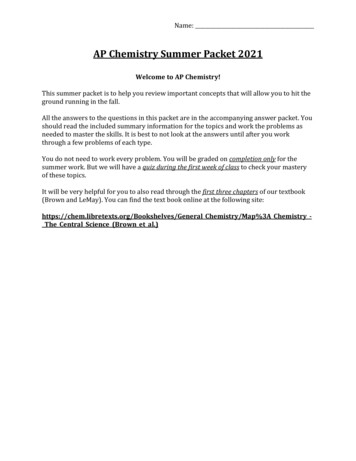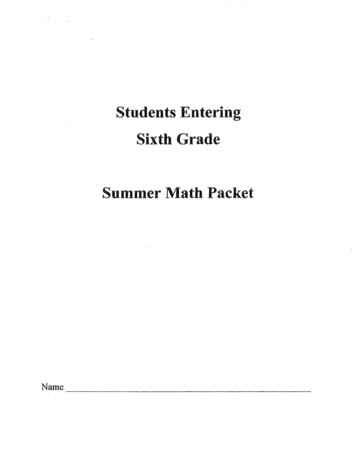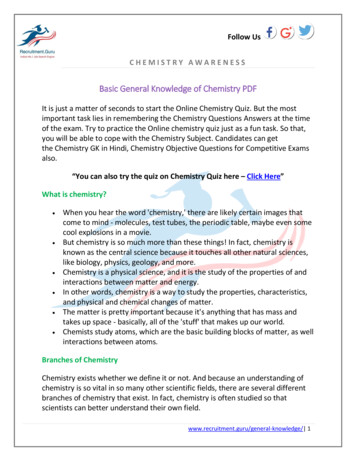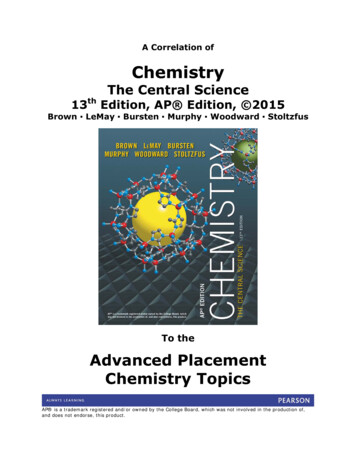
Transcription
Name:AP Chemistry Summer Packet 2021Welcome to AP Chemistry!This summer packet is to help you review important concepts that will allow you to hit theground running in the fall.All the answers to the questions in this packet are in the accompanying answer packet. Youshould read the included summary information for the topics and work the problems asneeded to master the skills. It is best to not look at the answers until after you workthrough a few problems of each type.You do not need to work every problem. You will be graded on completion only for thesummer work. But we will have a quiz during the first week of class to check your masteryof these topics.It will be very helpful for you to also read through the first three chapters of our textbook(Brown and LeMay). You can find the text book online at the following al Chemistry/Map%3A Chemistry The Central Science (Brown et al.)
Section 1: Significant FiguresAll measurements contain some error. Precision is how closely individual measurementsagree with each other. It is a function of the measuring device. The smaller the smallestdivisions on a measuring tool, the more precise the measurement. A ruler with millimeterdivisions is more precise than a ruler with only centimeter divisions. A balance thatmeasures to three decimal places (milligram) is more precise than one that measures totwo decimal places (centigram).Significant figures allow the level of precision of a measurement, and of calculations using ameasurement, to be accurately represented. At least one short answer question on the APexam will score you on your use of correct significant figures. It is very important that youget in the habit of using the correct number of significant figures in your calculations.Section 2: The Metric SystemThe metric system (specifically, the SI system, which is a subset of the metric system,though chemistry makes frequent use volume and pressure units that are not SI), is theaccepted system of units among scientists. It is essential that you are comfortable withusing the metric system. You must master the prefixes, particularly kilo-, centi-, milli-, andmicro-.Section 3: Chemical FormulasChemical nomenclature is no longer emphasized on the AP Chemistry exam; however, youare expected to know the names and symbols of common chemical elements. (The periodictable provided with the exam has symbols only.) You are also expected to know the chargesof the monoatomic ions of the alkali and alkaline earth metals, and the nonmetals.Additionally, it is very important be able to quickly recognize what type of compound asubstance is from its chemical formula. You will need to be able to do this in order to beable to explain its physical and chemical properties, or to be able to predict the products ofa reaction. Recognizing the formulas of common polyatomic ions is essential to this skill,though you do not need to memorize their names.Section 4: Balancing Equations and Reaction TypesJust like recognizing compounds, balancing equations and recognizing common reactiontypes are foundational skills. Mastery of these skills will enable you to more easily tacklecomplex problems. Plus, balancing equations is just fun.Section 5: Oxidation NumbersOxidation numbers are a way of keeping track of electrons in chemical reactions. Being ableto assign oxidation numbers to atoms in compounds allows you to recognize redoxreactions and track how electrons are transferred in these reactions2
Section 6: MolesThe mole is central to quantitative chemistry. It allows us to connect the macroscopicworld we see and can measure to the microscopic world of atoms and compounds. You willreview key methods of converting macroscopic measurements to quantities of microscopicatoms and compounds.Section 7: StoichiometryStoichiometry is the calculation of the quantities of products and reactants using chemicalequations. Stoichiometry calculations are central to the practical study and application ofchemistry. Stoichiometry problems will permeate nearly every unit of study in APchemistry. It is imperative that you take the time to understand the why behind eachmathematical step you take in a stoichiometry problem. Simply memorizing steps will notbe enough. Understanding the why behind chemical calculations will allow you to adaptyour skills to new problems.3
Section 1: Significant FiguresSignificant figures rules: countingSuppose we what to determine the number of significant digits in the followingmeasurement. In this method a “dot” is the decimal point.Example: 0.001230400Step 1 - Draw a box around all nonzero digits, beginning with the leftmostnonzero digit and ending with the rightmost nonzero digit in the number,including any sandwiched zeros.0.001230400Step 2 - If a dot is present, draw a box around any trailing zeros.0.0012304 00Step 3 - All the boxed digits are significant.There are 7 significant digitsA. Indicate the number of significant figures then round each to the number of significantfigures indicated.For example:1.234has 4 significant figures and, rounded to 2significant figures, is 1.21. 0.6034 has significant figures and, rounded to 2 significant figures, is2. 12,700 has significant figures and, rounded to 2 significant figures, is3. 12,700.00 has significant figures and, rounded to 1 significant figures, is4. 0.000983 has significant figures and, rounded to 2 significant figures, is5. 123342.9 has significant figures and, rounded to 5 significant figures, is6. 6.023 x 1023 has significant figures and, rounded to 2 significant figures, is7. 0.005600 has significant figures and, rounded to 1 significant figures, is4
8. 10000.5006 has significant figures and, rounded to 5 significant figures, is9. 2.0 x 10-3 has significant figures and, rounded to 1 significant figures, is10. 3.456110 has significant figures and, rounded to 3 significant figures, isSignificant figures rules: calculations1. Addition and subtraction:Limited by the number with the smallest number of decimal placesE.g.: 2.01 5.2 7.22. Multiplication and divisionAnswer has the same number of sig figs as the number with the fewest digitsE.g.: 6.00 2.0 123. Logarithms (important when we do pH)The number of decimal places in a log (in scientific notation) is equal to thenumber of sig figs in the original numberE.g.: [H ] 1.0 10 5 pH 5.00; pH 2.650 [H ] 2.24 10 3B. Given calculations with the calculator answer, write the answers with the appropriatenumber of significant figures.Example:6.00 x 3.00 18The answer should be18.01. 23 46 69The answer should be2. 23.0 46.0 69The answer should be3. 253 345.8 598.8The answer should be4. 56 – 35 21The answer should be5. 56.00 – 35.0 21The answer should be6. 46 x 12 552The answer should be7. 3.24 x 5.63 18.2412The answer should be5
8. (2.355 2.645) x 10.00 50The answer should be9. 654 32The answer should be 20.437510. 0.024 x .063 1.512 x 10-03The answer should be6
Section 2: Metric SystemImportant ter (m)grams (g)liters (L)moles (mol)molarity imicronanopicofemtodcmμnpf10n10610310210110010 110 210 310 610 910 1210 ius ( C) 273.15 Kelvin (K)*many equations require temperature in KelvinPressure (nonmetric)atmospheres (atm)millimeters of mercury (mm Hg), torrA. Use appropriate metric prefixes to write the following measurements without use ofexponents.1. 6.5 10 6 m:5. 12.5 10 8 kg:2. 6.35 10 4 L:6. 3.5 10 11 s:3. 2.5 10 3 L:7. 6.54 109 fs:4. 4.3 10 9 m:8. 2.45 104 g:B. Perform the following conversions:7
1. 25.5 mg to g2. 4.0 10 10 m to nm3. 0.575 mm to μm4. 1.48 102 kg to g5. 0.0023 μm to nm6. 7.25 10 4 s to ms8
Section 3: Chemical Formulas and Compound TypesIonic Compounds Expressed as an empirical formula (lowest whole-number ratio of ions) Binary ionic compoundso Composed of a metal monoatomic cation and a nonmetal monoatomic aniono You must know the charges of the following monoatomic ions: alkali metals (Group 1): 1 nitrogen, phosphorus: 3 alkaline earth metals (Group 2): 2 oxygen, sulfur: 2 aluminum, gallium: 3 halogens (Group 17): 1 carbon: 4 o Examples: NaCl, AlCl3, Fe2O3o Many of the transition metals can have more than one charge. You will needto recognize what charge a transition metal ion has based on its chemicalformula. For example: Fe2O3 is iron(III) oxide (Fe3 and O2 ) FeO is iron(II) oxide (Fe2 and O2 )Ionic compounds containing polyatomic ions (3 options)o Composed of a metal cation and a polyatomic anion Examples: Na2CO3, Fe(NO3)3o Composed of a polyatomic cation and a nonmetal anion Examples: NH3Cl, Hg2So Composed of a polyatomic cation and a polyatomic anion Examples: NH3C2H3O2, Hg2(NO3)2In water, soluble ionic compounds dissociate into their ionso The only solubility rules you have to memorize are: Ionic compounds (salts) containing sodium (Na ), potassium (K ),ammonium (NH4 ), and nitrate (NO3 ) ions are always solubleMolecular Compounds Atoms are joined in specific numbers by covalent bonds: formulas are molecularformulas, not empirical formulas Usually composed of nonmetals onlyo Examples: H2O, NH3, Cl2, C6H12O6, SiO2o NOTE: transition metals can sometimes form covalent bonds, but you willgenerally only see this (in AP Chemistry) in some polyatomic ions, which arealways a part of ionic compounds 2 Examples: Hg 2 2 , MnO4 , Cr2 O7Acids Acids are a type of molecular compoundo One or more hydrogen atoms, which are covalently bonded, dissociate(ionize) when dissolved in watero Usually composed of: hydrogen covalently bonded to a halogen Examples: HF, HCl, HBr, HI hydrogen covalently bonded to a polyatomic ion (frequently to anoxygen atom)9
Examples: HNO3, H2SO4, H3PO4, nSnWOsPtAuHgPossible Charges2 2 , 3 , 4 2 , 3 , 4 , 5 2 , 3 2 , 3 , 4 2 , 3 2 , 3 2 , 3 1 , 2 2 3 3 4 3 , 5 3 , 6 3 3 2 , 4 1 2 3 2 , 4 6 3 , 4 2 , 4 1 , 3 Polyatomic ulfitehydrogen sulfate(bisulfate)selenatecarbonatehydrogen sphitehydrogen phosphatedihydrogen phosphatearsenateborate1 (Hg22 ), 2 OtherClO4 ClO3 ClO2 ClO BrO3 IO3 NO3 NO2 MnO4 SO42 SO32 HSO4 SeO42 CO32 HCO3 SiO32 CrO42 PO43 PO33 HPO42 H2PO4 AsO43 BO33 leadPb2 , 4 bismuthBi3 , 5 **Metal ions with larger charges (4 and higher) tendto form bonds with grater covalent characterhydroxidecyanideOH CN acetateC2H3O2 formateperoxideCHO2 O22 Polyatomic CationsoxalateC2O42 ammoniumNH4 thiosulfateS2O32 hydroniumH3O dichromateCr2O72 10
A.Writing Ionic FormulasWhen writing the formulas of ionic compounds, remember that the net charge of thecompound must be zero. The cation always comes first, then the anion. When a polyatomicion is present more than once in a compound, surround the formula of the ion withparenthesis and place the subscript after the parenthesis.Example: Mg 2 and NO 3 become Mg(NO3)2Cl NO 3S 2 CO2 3N 3 PO3 4OH Na NH4 Sn2 Hg 2 2Al3 Sn4 B.Identifying CompoundsIdentify each of the following compounds as an ionic compound or a molecule. If themolecule is an acid, say so. For both ionic compounds and acids, write the formulas,including charges, of the two ions that the compound dissociates into in water.Examples: C6H12O6: molecule Na2O: ionic compound, 𝐍𝐚 and 𝐎𝟐 H2CO3: molecule, acid, 𝐇 and 𝐂𝐎𝟐 𝟑1. HCl2. PCl53. K2S4. NiSO45. ClF311
6. OF27. HIO38. Al(OH)39. NCl310. (NH4)3PO411. HBrO312. S2Cl213. CO214. (NH4)2CO315. H2S16. SCl217. HCN18. CaI219. BF320. H2C2O421. PI322. Mg(ClO4)223. KMnO424. HF25. AlPO426. O2F212
Nomenclature RulesYou do not need to memorized these rules, but being familiar with compound names willbe helpful.Ionic Compounds Name of cation ( ) first, name of anion ( ) secondo For monoatomic ions: cation is the element name, anion ends in “-ide”o For polyatomic ions: both cation and anion are just the name of the iono For transition metals that can have more than one charge, include the chargeas a roman numeral in parenthesis NaCl: sodium chloride (NH3)2SO4: ammonium sulfate FeO: iron(II) oxide; Fe2O3: iron(III) oxideo the old “–ous” and “-ic” suffixes are rarely in use; you do not need to knowthemBinary Molecular Compounds Usually the less electronegative atom comes first Indicate the number of atoms with a prefix.o Note: mono is not used on the first atom in a binarymolecular compoundo Drop the ending “a” on a prefix when the elementbegins with an “o” tetra oxide tetroxide The second atom ends in “-ide” Exampleso CO: carbon monoxideo CO2: carbon dioxideo N2O: dinitrogen monoxideNaming Acids (for use with monoatomic and polyatomic ions)13
Section 4: Balancing Equations and Reaction TypesA.The Law of Conservation of Mass says that matter cannot be created or destroyed.More simply stated, the atoms that go into a reaction must also come out.Balance the following equations so there are the same number of atoms of eachelement on both sides of the arrow.Synthesis Reactions1. CaO H2O Ca(OH)22. P4 O2 P2O53. Ca O2 CaO4. Cu S8 CuS5. Fe O2 Fe2O36. S8 O2 SO27. H2 N2 NH38. H2 Cl2 HCl9. Ag S8 Ag2S10. Cr O2 Cr2O311. Al Br2 AlBr312. Na I2 NaI13. H2 O2 H2O14. Al O2 Al2O3Decomposition Reactions15. BaCO3 BaO CO216. MgCO3 MgO CO217. K2CO3 K2O CO218. Zn(OH)2 ZnO H2O19. Fe(OH)2 FeO H2O20. Ni(ClO3)2 NiCl2 O221. NaClO3 NaCl O222. KClO3 KCl O223. H2SO4 H2O SO324. H2CO3 H2O CO225. Al2O3 Al O226. Ag2O Ag O214
Single Replacement Reactions27. AgNO3 Ni Ni(NO3)2 Ag28. AlBr3 Cl2 AlCl3 Br229. NaI Br2 NaBr I230. Ca HCl CaCl2 H231. Mg HNO3 Mg(NO3)2 H232. Zn H2SO4 ZnSO4 H233. K H2O KOH H234. Na H2O NaOH H2Double Displacement Reactions35. AlI3 HgCl2 AlCl3 HgI236. HCl NaOH NaCl H2O37. BaCl2 H2SO4 BaSO4 HCl38. Al2(SO4)3 Ca(OH)2 Al(OH)3 CaSO439. AgNO3 K3PO4 Ag3PO4 KNO340. CuBr2 AlCl3 CuCl2 AlBr341. Ca(C2H3O2)2 Na2CO3 CaCO3 NaC2H3O242. NH4Cl Hg2(C2H3O2)2 NH4C2H3O2 Hg2Cl243. Ca(NO3)2 HCl CaCl2 HNO344. FeS HCl FeCl2 H2S45. Cu(OH)2 HC2H3O2 Cu(C2H3O2)2 H2O46. Ca(OH)2 H3PO4 Ca3(PO4)2 H2O47. CaBr2 KOH Ca(OH)2 KBrCombustion Reactions48. CH4 O2 CO2 H2O49. C2H6 O2 CO2 H2O50. C3H8 O2 CO2 H2O51. C4H10 O2 CO2 H2O52. C5H12 O2 CO2 H2O53. C6H14 O2 CO2 H2O54. C2H4 O2 CO2 H2O55. C2H2 O2 CO2 H2O56. C6H6 O2 CO2 H2O15
B.Many reactions can be classified into the following categories.For each equation below identify the reaction type(s):o synthesis A B ABo decomposition AB A Bo single replacement A BC AC Bo double displacement AB CD AD CBo precipitation formation of a solid from two solutions use the solubility rules to determine if an ionic compound willprecipitate (not soluble)o oxidation-reduction (redox) electrons are transferred at least one atom changes its charge or oxidation state frequently an element goes from being a pure element to part of acompound, or from being part of a compound to being a pure elemento acid-base neutralization HA (acid) BOH (base) H2O (water) BA (ionic compound, salt)16
o combustion CxHy O2 CO2 H2O CxHy is a generic hydrocarbon; compounds containing carbon,hydrogen, and oxygen can also combust (Nitrogen compounds can also combust in oxygen to produceNOx compounds, but combustion is usually used to refer to thereaction of hydrocarbons in O2) predict the products write the balanced reactionFor example:Solutions of silver nitrate and magnesium iodide are combined.2AgNO3(aq) MgI2(aq) 2AgI(s) Mg(NO3)2(aq)Reaction types: precipitation, double displacement1. Ammonium sulfate reacts with barium nitrate.2. Zinc metal is added to a solution of copper(II) chloride.3. Propane gas (C3H8) is burned in excess oxygen.17
4. Iron metal shavings are added to hydrochloric acid.5. Magnesium and nitrogen gas are heated together.6. Chlorine gas is bubbled through a solution of sodium bromide.7. Solutions of lead(II) nitrate and calcium iodide are combined.8. Sulfuric acid is combined with sodium hydroxide.18
Section 5: Oxidation NumbersRules for assigning oxidation numbers1. For an atom in its elemental form, the oxidation number is always zero.a. For example, H in H2, P in P4, etc.2. For any monoatomic ion, the oxidation number equals the charge on the ion.3. Nonmetals usually have negative oxidation numbersa. Oxygen is 2, except in the O22 (peroxide) ion, where it is 1.b. Hydrogen is 1 when bonded to nonmetals and 1 when bonded to metals.c. Fluorine is always 1. All other halogens are usually 1, but are positivewhen bound to oxygen, as in oxyanions.4. The sum of the oxidation numbers of all the atoms in a neutral compound is zero.In a polyatomic ion, it equals the charge of the ion.Assign oxidation numbers to each element in the compounds below.a. P4O10g. Cu3PO4b. HFh. PCl3c. CaI2i. NaCNd. MnO2j. Cs3Ne. Li2Ok. Zn(NO3)2f. FeI3l. N2O19
Section 6: MolesThe starting point for nearly every quantitative chemistry question is to go from amacroscopic measurement (grams, liters) to moles.mass (g) 1 mol molesmolar mass (g)or moles molar mass (g)1 molConverting between mass (grams) and moles requires finding the molar mass (also calledmolecular weight, reported in g/mol) of the substance, which can be calculated from thechemical formula of the substance and the atomic masses of the elements, as found on theperiodic table.For Ax By , : molar mass x(atomic mass A) y(atomic mass B)Converting between volume of at gas and moles of a gas depends on the conditions the gasis stored under. The volume of a gas is dependent not only on the number of moles, but thetemperature and pressure. If the gas is at standard temperature and pressure (STP), whichis defined as a temperature of 0 C (273 K) and a pressure of 1 atm (760 torr, 101.3 kPa),the molar volume of the gas is 22.4 L. In this case, the conversion can be done with a simpleratio.1 mol22.4 L moles or moles volume (L)22.4 L1 molHowever, if the gas is not at STP, or if the question is asking for pressure instead of volume,the Ideal Gas Lawvolume (L) 𝑃𝑉 𝑛𝑅𝑇where P is pressure, V is volume, n is the number of gas particles, R is the universal gasconstant, and T is temperature. The units of each depend on the value of R.20
Temperature must be entered into the Ideal Gas Law using an absolute scale (starting atzero and increasing with increased temperature, rather than changing from negative topositive at an arbitrary point. Chemists use the Kelvin scale ( C 273 K).The two most common values of R both use liters for volume and moles for number ofparticles, but differ in pressure units: atm (atmospheres) or torr (which is essentiallyequivalent to millimeters of mercury, mm Hg).L atmL torror 62.36mol Kmol KThe Ideal Gas Law can be rearranged to solve for the variable in question, as long as theother three variables are known.𝑛𝑅𝑇𝑛𝑅𝑇𝑃𝑉𝑉 or 𝑃 or 𝑛 𝑃𝑉𝑅𝑇As you can see by plugging in STP, the molar volume of a gas at STP, 1 mol 22.4 L, is aconvenient shortcut derived from the Ideal Gas Law.𝑅 0.08206L atm)(0 273)𝑛𝑅𝑇 (1 mol)(0.08206 molK𝑉 22.4 L𝑃1 atmA great deal of chemistry is done in aqueous solutions, or solutions where water is thesolvent. Solutions are described by their concentration. Chemists use molarity to describeconcentration. Molarity is moles of solute per liter of solution (mol/L).mol) molesL1molmoles concentration ( M)volume (L)Lvolume (L) concentration (M orormoles 1L volume (L)concentration (mol)In experimental procedures, you will frequently need to make dilution calculations.Reagents are often stored as concentrated stock solutions, which are easily diluted intosolutions called working solutions for use in experiments. When making dilutioncalculations, use the formula𝑀1 𝑉1 𝑀2 𝑉2where 𝑀1 and 𝑉1 are the initial concentration and volume, respectively, and 𝑀2 and 𝑉2 arethe final concentration and volume, respectively. It doesn’t matter what units ofconcentration or volume you use, as long as they are the same on both sides of theequation.Most commonly, you will need to calculate the final concentration (𝑀2 ) after diluting astock solution𝑀2 𝑀1 𝑉1𝑉2or you will need to calculate the amount of stock solution needed to make a workingsolution (𝑉1).𝑀2 𝑉2𝑉1 𝑀121
A.Perform the following conversions1. 3.25 g of AlCl3 to moles2. 50.0 g of H2O2 to moles3. 12.6 L of Ar at STP to moles4. 1.54 L of SF6 at 5 C and 800 torr to moles5. 2.25 L of 0.250 M KSCN to moles6. 0.500 L of 1.25 M NaCl to moles7. 2.50 mol of C4H10 to grams8. 40.0 mol of Fe2O3 to grams9. 3.05 L of SO2 at STP to grams10. 75.0 mL of Xe at 150 C and 0.978 atm to grams11. 0.300 L of 1.15 M C6H12O6 to grams12. 5.30 L of 4.00 M CH4N2O to grams13. 1.35 mol of CO2 to liters of gas at STP22
14. 50.5 mmol of H2 to liters of gas at 20 C and 650 mm Hg15. 45.0 g of Rn to liters of gas at STP16. 25.0 mg H2S to pressure of gas (in atm) in 45.0 mL at 264 C17. 2.00 M NH3 in 0.200 L to liters of gas at STP18. 0.100 M N2 in 20.0 mL to liters of gas at 5 C and 2.50 atm19. 90.5 g of Cl2O7 in 2.25 L of solution to concentration (molarity)20. 1.20 g of P2O5 in 80.0 mL of solution to concentration (molarity)21. 20.3 L of NO2(g) at STP in 3.15 L of solution to concentration (molarity)22. 50.0 mL NH3(g) at 20 C and 65.0 atm in 75.0 mL of solution to concentration(molarity)23. Volume (in liters) of a 0.200 M solution that contains 25.0 g of MgCl224. Volume (in liters) of a 1.25 M solution that contains 500 mg of NH4Cl25. Volume (in liters) of a 0.250 M solution that would release 5.25 L of SO3(g) at STP26. Volume (in liters) of a 2.65 M solution that would release 40.0 L of NO2(g) at 75 C and500 torr23
B.Perform the following dilution calculationsCalculate the final concentrations (M2) for the following dilution series of a 25.0 μM stocksolution, given the volume of stock solution and volume of water added in each case. Keepin mind that the final solution contains both the stock solution and water.Stock Solution Volume(mL)Water Volume (mL)1.192.373.554.735.91SampleFinal Concentration(μM)Calculate the amount of stock solution needed (V1) to produce the following workingsolutions.6. 1.25 L of 0.375 M HCl from a 12.0 M stock solution7. 150 mL of 0.200 M NaOH from a 6.00 M stock solution8. 2.50 L of 100 mM NaCl from a 3.50 M stock solution9. 1.00 L of 5.25 μM crystal violet from a 3.00 mM stock solution10. 500 mL of 0.002 M Fe(NO3)3 from a 1.00 M stock solution24
Section 7: StoichiometryStoichiometry simply means using the ratios of atoms and compounds found in chemicalformulas and reactions to solve quantitative chemistry problems. Stoichiometrycalculations are found in nearly every unit of AP Chemistry. If you struggle with theseproblems, do not hesitate to seek help over the summer. It is essential that you master thisskill.Two key skills are finding the lowest whole-number ratio and using a molar ratio.You will need to find the lowest whole-number ratio when solving for the empiricalformula of compounds. To find the lowest whole-number ratio of molar amounts, divide allmolar amounts by the smallest molar amount. This assumes that the atom present leastfrequently is present only once, since dividing a number by itself equals 1. If numbers arereasonably close to a whole number, they can be rounded. These numbers become thesubscripts in your formula. For example:Na:S:O:0.701 mol / 0.352 mol 1.99 20.352 mol / 0.352 mol 11.41 mol / 0.352 mol 4.01 4Therefore: Na2SO4Not all formulas contain at least one atom that is only present once. If, after dividing by thesmallest molar amount, you obtain a number that ends in a decimal that’s close to arecognizable fraction, you will have to multiply all the subscripts by a number that willturn them into whole numbers. For example:Fe: 0.479 mol / 0.479 1 2 2O: 0.721 mol / 0.479 1.51 2 3.02 3Decimals to keep an eye out for are: .5 ½ .33 ⅓ .67 ⅔Therefore Fe2O3 .25 ¼ .75 ¾When finding the amounts of reactants needed or products produced for a particularreaction, you will need to use a molar ratio. All calculations must go through moles, sincechemical equations describe reactions in terms of the number of atoms and compoundsinvolved. The coefficients are the ratios by which reactants react to produce products. Forexample:3H2 N2 2NH3Every mole of nitrogen gas that reacts must react with 3 moles of hydrogen gas. For everymole of nitrogen gas that reacts, two moles of ammonia is produced, but for every threemoles of hydrogen gas that reacts, two moles of ammonia is produced. What if 5.00 mol ofhydrogen reacts: how much ammonia will be produced? To solve this, you must set up amolar ratio, which compares the number of moles of the two species that you areinterested in.25
5.00 molH2 2 molNH3 3.33 molNH33 molH2Notice that the values in the molar ratio come from the coefficients for each species. It isuseful to write the formula of the species next to the units (in this case, moles) in order tomake sure you have set up your molar ratio correctly. This is also useful when determiningthe limiting reactant (which reactant will run out first).Remember that the amount of product depends on the amount of the reactant that runs outfirst. Once that reactant, the limiting reactant, runs out, the reaction will stop and no moreproduct will be produced. When determining limiting reactant, remember that you mustnot only take into account which reactant is present in the smallest amount, but the ratio inwhich they are used. For example, if you react 2 mol of H2 with 1 mol of N2, there is less N2,but the H2 will run out first.Moles YouHaveMoles YouNeed2.00 molH2 1 molN2 0.667 molN23 molH21.00 molN2 3 molH2 3.00 molH21 molN2In this case, you have 2.00 mol of hydrogen gas, but in order to use up all the nitrogen gas,you would need 3.00 mol of hydrogen gas. You have less than you would need. Meanwhile,you have 1.00 mol of nitrogen gas, but you only need 0.667 mol of nitrogen gas to use up allthe hydrogen gas. You have an excess of nitrogen gas. Therefore, the reaction will proceeduntil all 2.00 mol of H2 is used up and 0.667 mol of N2 mol has been used. You will have0.333 mol of nitrogen gas left over. The amount of ammonia made depends on the amountof hydrogen, since hydrogen is the limiting reactant.2.00 molH2 2 molNH3 1.33 molNH33 molH2Solve the following problems:1. An ionic compound is found to contain 1.5 g of calcium, 1.9 g of arsenic, and 1.6 g ofoxygen. Find the empirical formula of this compound.26
2. Benzene contains only carbon and hydrogen and has a molar mass of 78.1 g/mol.Analysis shows the compound to be 7.74% H by mass. Find the empirical and molecularformulas of benzene.3. Find the mass percent of nitrogen in each of the following compounds:a. NOb. NO2c. N2O4d. N2O27
4. Calcium carbonate decomposes upon heating, producing calcium oxide and carbondioxide gas.a. Write a balanced chemical equation for this reaction.b. How many grams of calcium oxide will remain after 12.25 g of calcium carbonate iscompletely decomposed?c. What volume of carbon dioxide gas is produced from this amount of calciumcarbonate? The gas is measured at 0.95 atm and 10 C.5. Hydrogen gas and bromine gas react to form hydrogen bromide gas.a. Write a balanced chemical equation for this reaction.b. How many grams of hydrogen bromide gas can be produced from 3.2 g of hydrogengas and 9.5 g of bromine gas?c. How many grams of which reactant is left unreacted?d. What volume of HBr, measured at STP, is produced in (b)?28
6. When ammonia gas, oxygen gas and methane gas (CH4) are combined, the products arehydrogen cyanide gas and water.a. Write a balanced chemical equation for this reaction.b.Calculate the mass of each product produced when 225 g of oxygen gas is reactedwith an excess of the other two reactants.c.If the actual yield of the experiment in b) is 105 g of HCN, calculate the percentyield.7. What mass of potassium nitrate is produced when 50.0 mL of 0.200 M Al(NO3)3 reactswith 200.0 mL of 0.100 M KOH?8. Potassium nitrate decomposes when heated, forming potassium nitrite and oxygen gas.a. Write a balanced chemical equation for this reaction.b. What mass of KNO3 would
AP Chemistry Summer Packet 2021 Welcome to AP Chemistry! This summer packet is to help you review important concepts that will allow you to hit the ground running in the fall. All the answers to the questions in this packet are in the accompanying answer packet. You should read the inc










